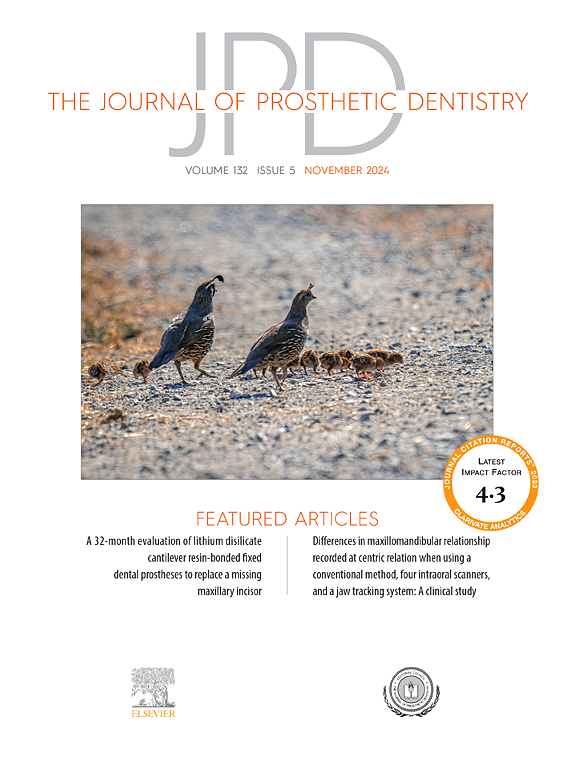Potential risks, treatment strategies, and treatment outcomes of retrograde peri-implantitis: A systematic review
IF 4.8
2区 医学
Q1 DENTISTRY, ORAL SURGERY & MEDICINE
引用次数: 0
Abstract
Statement of problem
Potential risk factors of retrograde peri-implantitis have been identified from literature reviews; however, only clinical reports or isolated risk factors were evaluated. Retrograde peri-implantitis likely involves multifactorial risks, and outcomes following treatment remain underexplored.
Purpose
The purpose of this systematic review was to identify factors associated with retrograde peri-implantitis occurrence and evaluate outcomes following specific treatment approaches.
Material and methods
A systematic search was performed in PubMed, Cochrane Database of Systematic Reviews, and SCOPUS databases up to December 2024 without language restriction, followed by a manual search. The review followed the population, intervention, control, outcome, study type (PICOS) criteria by including observational human studies on dental implants, with or without prostheses, reporting factors associated with retrograde peri-implantitis occurrence or treatment outcomes following treatment. Retrograde peri-implantitis was defined as progressive bone loss at the implant periapex, with or without clinical symptoms. Exclusion criteria included review articles, case series, and clinical reports, studies lacking a clear definition of retrograde peri-implantitis, or those reporting only retrograde peri-implantitis occurrence. Mixed-population studies were excluded unless retrograde peri-implantitis was clearly reported separately. Clinical outcomes following treatment were assessed, and the risk of bias was assessed using the modified Newcastle-Ottawa scale.
Results
Nine observational studies were evaluated: 2 case-control, 3 retrospective cohort, 1 prospective cohort, and 3 ambispective studies. The ambispective studies collected implant data from dental records of recalled patients and followed up on treatment outcomes after retrograde peri-implantitis management. Occurrence of retrograde peri-implantitis ranged from 0.9% to 23.8%. Higher rates of retrograde peri-implantitis were reported in periapical lesions at the extraction sites or adjacent teeth, periodontitis at the extraction site, and shorter distance between the implant and adjacent teeth. After at least 1-year of follow-up, surgical treatments revealed survival rates of 66.7% to 100%, while the endodontic treatment of the adjacent tooth yielded 49% to 100% survival rates.
Conclusions
Within the limitations of current evidence, the occurrence of retrograde peri-implantitis tended to be associated with periapical lesions of teeth at implant recipient sites and adjacent teeth, exacerbated by close implant proximity to adjacent teeth, and periodontitis at the recipient sites. Comprehensive management of potential risk factors, including surgical intervention for retrograde peri-implantitis-affected implant and endodontic treatment of adjacent teeth with periapical lesions, may improve long-term implant survival.
逆行性种植体周围炎的潜在风险、治疗策略和治疗结果:一项系统综述。
问题陈述:从文献综述中确定了逆行性种植体周围炎的潜在危险因素;然而,仅对临床报告或孤立的危险因素进行了评估。逆行性种植体周围炎可能涉及多因素风险,治疗后的结果仍未得到充分探讨。目的:本系统综述的目的是确定与逆行性种植体周围炎发生相关的因素,并评估采用特定治疗方法后的结果。材料和方法:在PubMed、Cochrane系统评价数据库和SCOPUS数据库中进行系统检索,检索截止到2024年12月,无语言限制,然后进行人工检索。该综述遵循了人群、干预、对照、结果、研究类型(PICOS)标准,包括对种植体的观察性人类研究,包括有或没有种植体,报告与逆行种植体周围炎发生相关的因素或治疗后的治疗结果。逆行性种植体周围炎定义为种植体周围的进行性骨质流失,有或无临床症状。排除标准包括综述文章、病例系列、临床报告、缺乏明确定义的逆行性种植体周围炎的研究,或仅报道发生逆行性种植体周围炎的研究。除非单独明确报道逆行性种植体周围炎,否则排除混合人群研究。评估治疗后的临床结果,并使用改良的Newcastle-Ottawa量表评估偏倚风险。结果:共评价了9项观察性研究:2项病例对照研究、3项回顾性队列研究、1项前瞻性队列研究和3项双视角研究。该双视角研究从召回患者的牙科记录中收集了种植体数据,并随访了逆行性种植体周围炎治疗后的治疗结果。逆行性种植体周围炎的发生率为0.9% ~ 23.8%。据报道,在拔牙部位或邻近牙齿的根尖周病变、拔牙部位的牙周炎以及种植体与邻近牙齿之间较短的距离中,逆行性种植体周围炎的发生率较高。经过至少1年的随访,手术治疗的存活率为66.7% ~ 100%,而邻牙根管治疗的存活率为49% ~ 100%。结论:在现有证据的限制下,逆行性种植体周炎的发生往往与种植体受体位置和邻近牙齿的牙尖周病变有关,并且由于种植体与邻近牙齿的距离太近而加剧,以及种植体受体位置的牙周炎。综合处理潜在的危险因素,包括手术干预逆行种植体和根尖周围病变的邻牙的根管治疗,可能会提高种植体的长期存活率。
本文章由计算机程序翻译,如有差异,请以英文原文为准。
求助全文
约1分钟内获得全文
求助全文
来源期刊

Journal of Prosthetic Dentistry
医学-牙科与口腔外科
CiteScore
7.00
自引率
13.00%
发文量
599
审稿时长
69 days
期刊介绍:
The Journal of Prosthetic Dentistry is the leading professional journal devoted exclusively to prosthetic and restorative dentistry. The Journal is the official publication for 24 leading U.S. international prosthodontic organizations. The monthly publication features timely, original peer-reviewed articles on the newest techniques, dental materials, and research findings. The Journal serves prosthodontists and dentists in advanced practice, and features color photos that illustrate many step-by-step procedures. The Journal of Prosthetic Dentistry is included in Index Medicus and CINAHL.
 求助内容:
求助内容: 应助结果提醒方式:
应助结果提醒方式:


